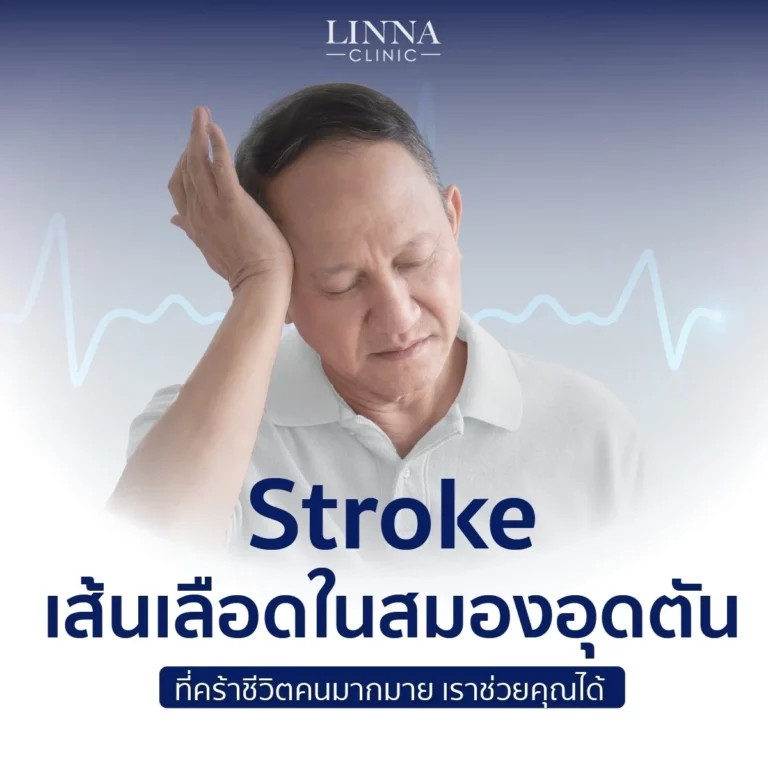Stroke or cerebrovascular disease, is a major cause of hemiplegia, paralysis, and weakness in the limbs, making it difficult for patients to carry out their daily activities. In severe cases of acute cerebral ischemia, it can even be fatal. Many people have heard of stroke and may think it’s something that won’t happen to them, but in reality, stroke can occur at any age and in any gender, especially in those with underlying risk factors. What causes stroke? What are the early symptoms? How can we prevent stroke? What is Stroke? What are the main causes of Stoke and what are the early symptoms? How to prevent stroke? This article from LINNA Clinic provides answers and introduces a new and promising treatment option for stroke recovery: Ozone Therapy (EBOO PLUS Technique) by experienced physicians at LINNA Clinic.
Table of Contents
What is Stroke or Cerebrovascular Disease?
Stroke, cerebrovascular disease, occurs when the blood supply to the brain is interrupted, often due to a blood clot or a burst blood vessel. This deprives brain cells of oxygen and nutrients, causing them to die. Without prompt treatment, stroke can lead to permanent disability, paralysis or even death.
Symptoms of Stroke or Cerebrovascular Disease
Symptoms of a stroke can vary depending on the area of the brain affected. Common signs include:
- Sudden numbness or weakness of the face, arm, or leg, especially on one side of the body.
- Sudden confusion, trouble speaking or understanding.
- Sudden trouble seeing in one or both eyes.
- Sudden trouble walking, dizziness, or loss of balance.
- Sudden severe headache with vomiting with no known cause.
If you or someone you know experiences any of these initial symptoms, whether they are short-lived and resolve on their own due to a transient ischemic attack (TIA), or persist for several hours, it is crucial to seek immediate medical attention from a specialist. A thorough medical evaluation will allow for a proper diagnosis and prompt treatment plan to reduce the risk of stroke, paralysis, and death
Complications of Stroke or Cerebrovascular Disease
Patients who have experienced a stroke may encounter various complications. These can include:
- Hemiplegia: Paralysis on one side of the body, affecting the face, arm, leg, or foot.
- Cognitive impairments: Memory loss, difficulty with understanding, and slower decision-making, especially for complex tasks. Speech problems such as slurred speech or difficulty finding words.
- Difficulty swallowing: This can lead to choking and an increased risk of pneumonia or other infections.
- Bowel and bladder problems: Constipation and difficulty controlling urination are common.
- Bleeding in the brain or gastrointestinal tract: This can be a complication of blood-thinning medications.
- Emotional disturbances: Patients may experience mood swings, irritability, feelings of worthlessness, and an increased risk of depression.
Causes of Stroke or Cerebrovascular Disease
Strokes, whether caused by a blood clot or a burst blood vessel, can be triggered by a variety of factors, both internal and external.
Internal Risk Factors (Often Inheritable):
- Aging: The blood vessels in the brain tend to deteriorate with age, especially after 55.
- Heart conditions: Such as arrhythmias, infective endocarditis, or heart failure.
- Blood disorders: Including polycythemia, thrombocytopenia, or clotting disorders.
- Gender: Men are more likely to experience a stroke than women.
- Genetics: A family history of stroke increases individual risk.
External Risk Factors (Often Lifestyle-Related):
- High blood pressure
- Diabetes
- High cholesterol
- Smoking
- Excessive alcohol consumption
- Obesity and lack of exercise
- Certain birth control pills, especially those high in estrogen
- Use of drugs, stimulants, or certain medications
Stroke or Cerebrovascular Disease Prevention
Stroke is a serious condition that can affect anyone at any age, often without warning. However, you can take steps to strengthen your body and reduce your risk of stroke by:
- Eating a balanced diet: Focus on a variety of foods, and limit your intake of spicy, sugary, salty, and fatty foods.
- Managing your health conditions: Keep your blood pressure, cholesterol, and blood sugar levels under control. If you’re taking medication, take it as prescribed.
- Prioritize sleep: Get enough rest and manage stress effectively.
- Stay active: Engage in regular physical activity and maintain a healthy weight.
- Quit smoking: Avoid cigarettes, e-cigarettes, and secondhand smoke. Limit alcohol consumption.
- Avoid substances: Stay away from drugs and stimulants.
Stroke Rehabilitation Program
Stroke, a cerebrovascular disease, is a serious health condition that can occur unexpectedly. If you notice any unusual symptoms such as numbness or weakness on one side of your face, arm, or leg; difficulty speaking; confusion; vision problems; or a severe headache, seek medical attention immediately. A specialist can diagnose the cause and recommend appropriate treatmentTo aid in recovery, patients can follow their prescribed medication regimen, adopt healthier lifestyle habits, and consider a specialized stroke rehabilitation program. LINNA Clinic offers an Ozone Therapy (EBOO PLUS Technique) as part of its stroke rehabilitation program. This therapy involves blood filtration and introducing a small amount of medical-grade ozone directly into the bloodstream over a period of time. The ozone is believed to stimulate blood cells, which can help the body heal and recover, particularly during recovery periods. It helps to heal people who already have stroke and can help to lower the risk of people who may have stroke. If you are interested in learning more about Ozone Therapy (EBOO PLUS Technique) please feel free to add us on Lineofficial at @linnaclinic or whatsapp us at +66919799554 or contact us at 063-609-8888 to schedule a detailed health assessment and create a personalized recovery plan for stroke patients or anyone who have high risk of stroke. Our experienced physicians, with over 12 years of experience and over 20,000 successful treatment cases, will provide tailored care.




